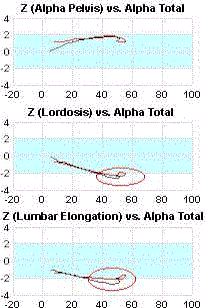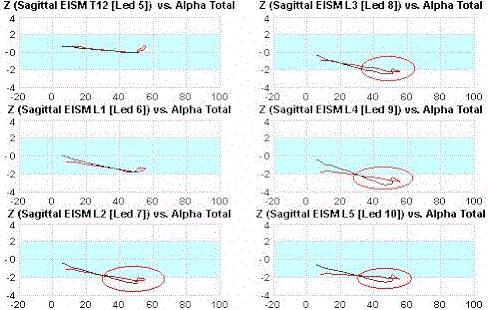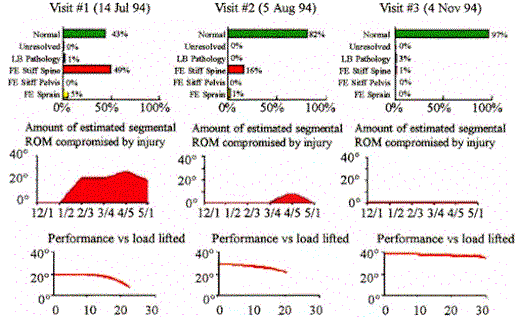Disc Herniation and Sciatica
This example illustrates how the Spinex International can be used to
track changes in a patient's spinal function during conservative care. The Spinex International can
provide information to assist in deciding upon diagnoses and treatment plans, or be used
as a management tool monitor the progress of therapy.
History
The patient was a 31 year old
female with pain in her lower back and sciatica in her left leg. An initial CT scan
revealed a disc herniation at L5/S1.
Spinoscopy
The patient's biomechanical
performance parameters were compared to the normal values for a 31-year-old female,
lifting the same loads.

For each parameter, the distance between the normal and
patient values was established. Where the patient value falls outside of the blue
"normal" zone, there is an indication of functional abnormality.
Illustrating this, although pelvic motion is relatively
high, it falls within in the upper range of normality. Alpha Total for sagittal flexion
shows the gross angle of the trunk with respect to the vertical.
Note that the patient showed a problem when bending. Beyond
30 degrees, the lordosis (spinal curvature) was affected. This was confirmed by the lumbar
elongation graph, where, at 30 degrees of flexion, the patient data fell outside of the
normal zone.
It was possible to estimate which spine level contributed
most to the restriction in mobility by analyzing individual lumbar segments, comparing the
contribution for each vertebral segment to that of the normal individual. The distance to
normality was calculated and expressed in terms of Z-score.
The following six graphs represent the
variation in Z-score of the estimated intersegmental mobilities for each vertebral level.
The patient begins to show dysfunction at L2/3, with the largest restriction at the L4/5
level.

The patient’s function is acceptable for small
amplitudes (less than 20 degrees) of trunk flexion and worsens with greater angles of
trunk motion.
Evaluating Patient Progress
The Spinex International Expert System provides information on the normality of biomechanical response,
with a list of potential causes explaining the loss of normality. The estimated portion of
the range of motion (ROM) affected by the injury is given for each lumbar segment and a
global index of performance, known as the index of normality, is assigned. The
accompanying reports serve to illustrate the patient’s progress over time.

On the patient’s first visit, for all loads lifted,
her performance was less than 50%. The overall normality of her response was 43%. Spine
stiffness during flexion extension (FE) was high (49%), and a minor sprain was detected
(6%). Function of the middle and lower lumbar spine, from L2/3 to L5/1, was restricted.
Abnormality was also seen during lateral bending (LB), suggesting a possible torsional
injury at L4/5.
The patient undertook conservative rehabilitation and came
back three weeks later. Upon re-evaluation, performance had improved. Dysfunction appeared
only at the L4/5 level, and the patient had an index of normality of 82%.
Outcome
After four months, on the
patient’s final visit, L4/5 function had improved to within normal values, although a
minor torsional problem remained (LB pathology 3%). Her overall index of normality was
97%.
<Back>